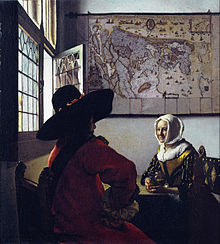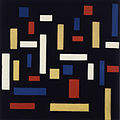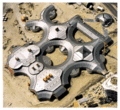- Dutch art
-
Dutch art describes the history of visual arts in the Netherlands, after the United Provinces separated from Flanders. Earlier painting in the area is covered in Early Netherlandish painting and Renaissance art.
Golden Age
Main article: Dutch Golden Age paintingDutch Golden Age painting was among the most acclaimed in the world at the time, during the seventeenth century. There was an enormous output of painting, so much so that prices declined seriously during the period. From the 1620s, Dutch painting broke decisively from the Baroque style typified by Rubens in neighboring Flanders into a more realistic style of depiction, very much concerned with the real world. Types of paintings included historical paintings, portraiture, landscapes and cityscapes, still lifes and genre paintings. In the last four of these categories, Dutch painters established styles upon which art in Europe depended for the next two centuries. Paintings often had a moralistic subtext. The Golden Age never really recovered from the French invasion of 1671, although there was a twilight period lasting until about 1710.
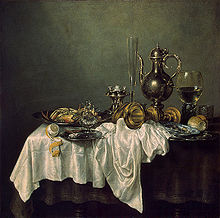 Willem Claeszoon Heda. Breakfast with a Lobster (seventeenth century).
Willem Claeszoon Heda. Breakfast with a Lobster (seventeenth century).
Dutch painters, especially in the northern provinces, tried to evoke emotions in the spectator by letting him/her be a bystander to a scene of profound intimacy. Portrait painting thrived in the Netherlands in the seventeenth century. A great many portraits were commissioned by wealthy individuals. Group portraits similarly were often ordered by prominent members of a city's civilian guard, by boards of trustees and regents, and the like. Often group portraits were paid for by each portrayed person individually. The amount paid determined each person's place in the picture, either head to toe in full regalia in the foreground or face only in the back of the group. Sometimes all group members paid an equal sum, which was likely to lead to quarrels when some members gained a more prominent place in the picture than others. Allegories, in which painted objects conveyed symbolic meaning about the subject, were often applied. Many genre paintings, which seemingly only depicted everyday life, actually illustrated Dutch proverbs and sayings, or conveyed a moralistic message, the meaning of which is not always easy to decipher nowadays. Favourite topics in Dutch landscapes were the dunes along the western sea coast, rivers with their broad adjoining meadows where cattle grazed, often a silhouette of a city in the distance.
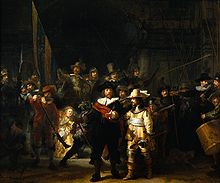 The Night Watch by Rembrandt
The Night Watch by Rembrandt
Rembrandt had by 1631 established such a good reputation that he received several assignments for portraits from Amsterdam. In about 1640, his work became more sober, reflecting the family tragedies that he had suffered. Exuberance was replaced by more sincere emotions. Biblical scenes were now derived more often from the New Testament instead of the Old Testament. One of his most famous paintings is The Night Watch, which was completed in 1642, at the peak of Holland's golden age. The painting was commissioned to be hung in the banquet hall of the newly built Kloveniersdoelen (Musketeers' Meeting Hall) in Amsterdam.
Johannes Vermeer's works are admired for their transparent colors, careful composition, and brilliant use of light. Vermeer painted mostly domestic interior scenes, and even his two known landscapes are framed with a window. The interior scenes are usually genre pieces or portraits. One of his most well known works is Girl with a Pearl Earring.
Utrecht School refers to a group of painters active in the city of Utrecht in the Netherlands in the early part of the seventeenth century. It is part of what is called Baroque. They were all strongly influenced by the then recently deceased Caravaggio, who died in 1610.
The Bamboccianti were a group of Dutch genre painters active in Rome from 1625-1700, during high and late Baroque. Their works were typically small parlor paintings or etchings of everyday life, including peasants in picturesque scenes.
Nineteenth century
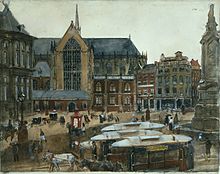 The Dam, Amsterdam (c.1895) by George Hendrik Breitner
The Dam, Amsterdam (c.1895) by George Hendrik Breitner
The Hague School were around at the start of the nineteenth century. They included Jozef Israëls. Jacob Maris showed all that is gravest or brightest in the landscape of Holland, all that is heaviest or clearest in its atmosphere. "No painter," says M. Philippe Zilcken, " has so well expressed the ethereal effects, bathed in air and light through floating silvery mist, in which painters delight, and the characteristic remote horizons blurred by haze; or again, the grey yet luminous weather of Holland.
Amsterdam Impressionism was current during the middle of the Nineteenth century at about the same time as French Impressionism. The painters put their impressions onto canvas with rapid, visible strokes of the brush. They focused on depicting the everyday life of the city. Late nineteenth-century Amsterdam was a bustling centre of art and literature. Famous painters among the Amsterdam Impressionists include George Hendrik Breitner, Willem de Zwart, Isaac Israëls, Simon Duiker and Jan Toorop. George Hendrik Breitner introduced a realism to the Netherlands that created shock waves similar to that of Courbet and Manet's in France. He was the painter of city views par excellence: wooden foundation piles by the harbour, demolition work and construction sites in the old centre, horse trams on the Dam, or canals in the rain. By the turn of the century Breitner was a famous painter in the Netherlands, as demonstrated by a highly successful retrospective exhibition at Arti et Amicitiae in Amsterdam (1901). When the streets of Amsterdam are grey and rainy, people of Amsterdam whisper grimly "Echt Breitnerweer" (Typical Breitnerweather).
Twentieth century
Around 1905-1910 pointillism as practiced by Jan Sluyters, Piet Mondrian and Leo Gestel was flourishing. Between 1911 and 1914 all the latest art movements arrived in the Netherlands one after another including cubism, futurism and expressionism. After World War I, De Stijl (the style) was led by Theo van Doesburg and Piet Mondrian and promoted a pure art, consisting only of vertical and horizontal lines, and the use of primary colors.
The Design Academy was established in 1947.
-
Gerrit Rietveld (1917)
European art Sovereign
states- Albania
- Andorra
- Armenia
- Austria
- Azerbaijan
- Belarus
- Belgium
- Bosnia and Herzegovina
- Bulgaria
- Croatia
- Cyprus
- Czech Republic
- Denmark
- Estonia
- Finland
- France
- Georgia
- Germany
- Greece
- Hungary
- Iceland
- Ireland
- Italy
- Kazakhstan
- Latvia
- Liechtenstein
- Lithuania
- Luxembourg
- Macedonia
- Malta
- Moldova
- Monaco
- Montenegro
- Netherlands
- Norway
- Poland
- Portugal
- Romania
- Russia
- San Marino
- Serbia
- Slovakia
- Slovenia
- Spain
- Sweden
- Switzerland
- Turkey
- Ukraine
- United Kingdom
- (England
- Northern Ireland
- Scotland
- Wales)
- Vatican City
States with limited
recognition- Abkhazia
- Kosovo
- Nagorno-Karabakh Republic
- Northern Cyprus
- South Ossetia
- Transnistria
Dependencies
and other territories- Åland
- Faroe Islands
- Gibraltar
- Guernsey
- Jan Mayen
- Jersey
- Isle of Man
- Svalbard
Categories:
Wikimedia Foundation. 2010.

